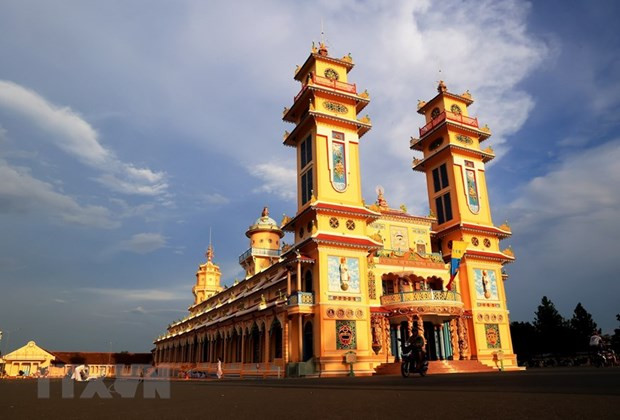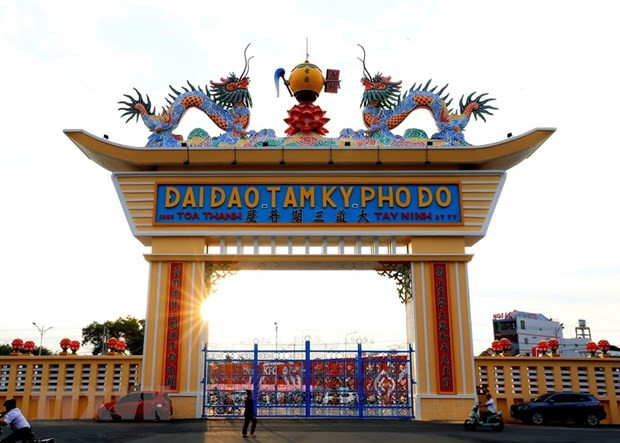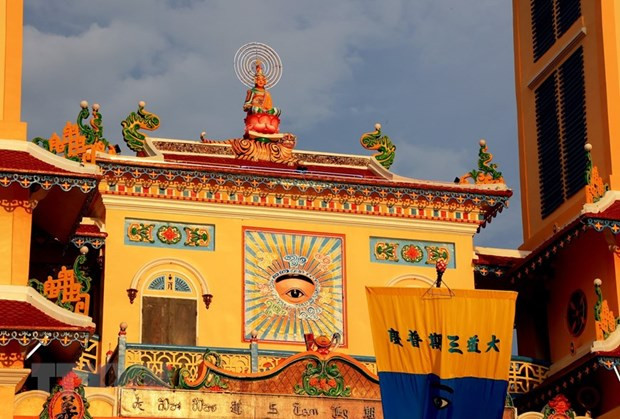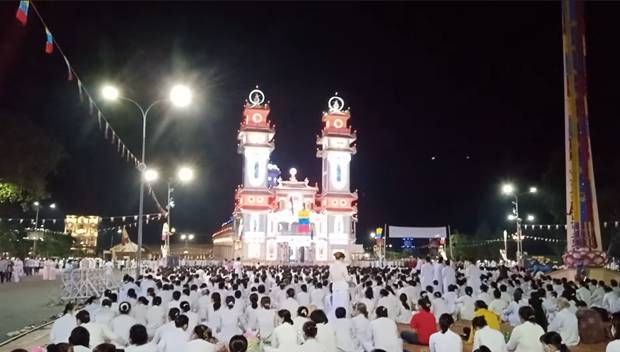While other projects have architects designing and building according to drawings, the Tay Ninh Holy See was built by Pham Ho Phap without any documents or drawings but entirely based on workers.

Tay Ninh Holy See, also known by locals as the Holy Temple, is located on Pham Ho Phap Street, Hoa Thanh Town, Tay Ninh Province.
Considered one of the greatest religious architectural works of Cao Dai, Tay Ninh Holy See converges unique architectural styles that attract thousands of visitors every year.
Tay Ninh Holy See - the central worship facility of Cao Dai religion
While large projects are often designed and built by architects according to drawings, Cao Dai Tay Ninh Holy See was built by His Holiness Pham Ho Phap without any documents or drawings, but entirely based on the efforts and hands of workers.
Construction began in 1933 and was completed in 1947, but it was not inaugurated until 1955. The Tay Ninh Holy See was built by the people without any cost, and they did not even get married during the construction period to ensure the right balance of yin and yang for the project. All theories about the size and architecture were directed by His Holiness Ly Giao Tong Giang Co to be implemented by the people.
The inner area of the Holy See is 1 square kilometer wide. The layout of this structure contains philosophical and religious or mystical views. According to the scriptures, the Holy See represents the White Jade Sutra residing in the world. Some easily recognizable symbols such as the statue of the Dharma Protector, the statue of Mr. Thien… are made very meticulously and elaborately.
The fence surrounding the inner area of the Holy See has nearly 100 large and small architectural works such as the Holy See, religious agencies, stupas... linked together. Wide roads connect these works.

Basically, the Tay Ninh Holy See project converges many unique architectures from many religious projects in the world. This is also a project that clearly demonstrates the tenets of Cao Dai religion, which is: Three religions return to the origin, Restore the Five Branches.
The actual size of the Holy See is 97.5m long and 22m wide, similar to the bell tower system in Catholic churches. The middle part of the Holy See of Tay Ninh is designed with a statue of Maitreya Buddha on the roof.
The Long Ma Bai Su is the overall image of this religious architectural work. The appearance of the Long Ma head on the front of the Holy See looks straight to the West. Above are two bell and drum towers rising high like two pairs of sharp horns. In the middle of the drum and bell towers is a ground floor building called Tinh Tam Dai.
The second floor of the Holy See is called Phi Tuong Dai, like the forehead with two doors considered as the two eyes of Long Ma. The Cuu Trung Dai area is the body, followed by Hiep Thien Dai. The tail of Long Ma is located at the end of the Holy Temple in the Bat Quai Dai area. This sacred religious building is built with bamboo reinforced concrete, typical of the Holy See buildings of Cao Dai religion.
The image of Tay Ninh Holy See also reminds visitors of the circle of Heaven and the square of Earth. These are also theories of the universe in Confucianism.
The Bagua Tower of the Tay Ninh Holy See has a shape similar to the Bagua Map of Taoism. On the roof of this detail are 3 Buddha statues. Inside the Tay Ninh Holy See was built a Nine-layer Tower with 9 levels from low to high.

The area surrounding the Holy See has 12 Tam Quan gates built in 3 different architectural styles. The main gate is Chanh Mon, the remaining 11 gates are numbered from 1 to 11.
There are a total of 112 round pillars around the Holy See supporting the porch roof in the corridor. The window frames decorated with lotus motifs support a frame of the Eye of Heaven, in the middle there is an equilateral triangle surrounding the wall of the Great Hall. There are a total of 23 lotus panels in the shape of the Eye of Heaven. The main entrance through the Tinh Tam Palace has a total of 6 side entrances and on both sides there are statues of Kim Mao Hau.
Unique at Tay Ninh Holy See
As the birthplace of Cao Dai, Tay Ninh has long been a holy land for tens of thousands of followers across the country with two of the most important festivals in indigenous beliefs.
Feast of the Supreme Being:Taking place on January 9 every year. This is one of the famous Tay Ninh Holy See festivals known by many locals and tourists. This is also the biggest festival of the year held at this construction.
During the festival, thousands of people will be present outside the Tay Ninh Holy See to admire the unique beauty of the incense dragon. In addition, visitors will also witness the joyful and unique dances of the unicorn, turtle, phoenix, dragon horse, etc.
The ethnic orchestra system was also performed in front of the Holy Temple, Bao An Tu, creating an extremely vibrant sound. After that, this orchestra will parade through the East and West stands, creating an extremely vibrant scene.
Visitors to the Tay Ninh Holy See during the festival can also experience many booths displaying historical models... With this activity, you will partly understand more about the culture, human values of the people and traditions of the Vietnamese nation.

Yaochi Palace Banquet:Held on the 15th day of the 8th lunar month, Tay Ninh Holy See Banquet is one of the festivals that attracts a large number of people and tourists.
The festival begins with a unique Dragon Dance performance including Dragon, Unicorn, Turtle, and Phoenix. Visitors will be immersed in an extremely bustling atmosphere.
The Tay Ninh Holy See's incense dragon dance is one of the unique activities in the ceremony, visitors should not miss it when visiting this place. In addition, the communal vegetarian meal at the Tay Ninh Holy See is also one of the unique activities in this Festival.
In the days leading up to the festival, you will feel the hustle and bustle as the locals prepare and decorate the roads and trees for the festival.
The ceremony is held with religious activities such as worshiping, carrying a flower palanquin, dancing with dragons, unicorns, turtles, phoenixes, etc. The procession of the Buddha's flower palanquin is the biggest activity of this festival. This is also a very elaborate performance by the parishioners here.
According to Vietnam+